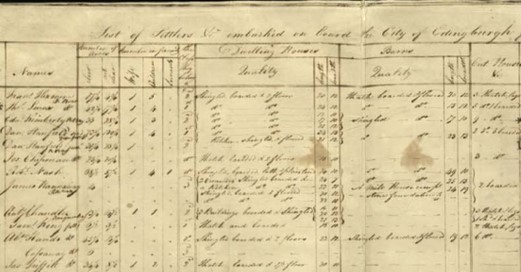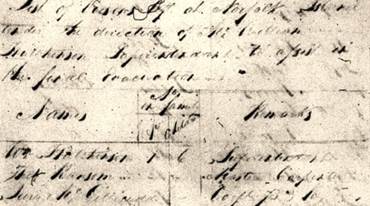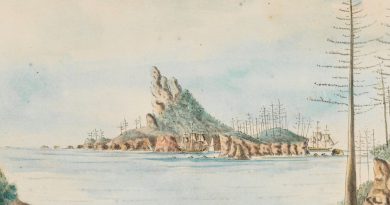City of Edinburgh 1808 Norfolk Island
The City of Edinburgh arrived at Norfolk Island on 4 June 1808; after three months delay she sailed from Norfolk Island to Derwent River, Van Diemen’s Land (VDL) on 9 September 1808 as part of Norfolk Island’s evacuation orders pertaining to the closure of the Island’s settlement, anchoring at Hobart Town harbour on 2 October 1808: The unfortunate people suffered much on the long voyage of nearly a month, and complained that they had been plundered on the way of much of their small property. The greater numbers were in a most destitute state, almost naked, and their arrival necessarily increased the prevailing distress at Hobart.
In Oct 1808, VDL Lieutenant Governor David Collins reported that there were 242 arrivals, yet in May 1809 he reports that from the City of Edinburgh were 83 settlers, 39 wives, 96 children and eight male convicts totalling 226 people, giving a difference of 16 people. In the past many historians and writers have used the Collins report of May 1809 as the actual passenger numbers of 226 aboard the City of Edinburgh in 1808, such as Frank Clune in The Norfolk Island Story, all have failed to consult the four different shipping manifests of the City of Edinburgh which totally contradict both of Collins’s reports.
On 24 Feb 1808 the City of Edinburgh was chartered to transfer settlers from Norfolk Island to the Derwent and return to Port Jackson. The Commandant on Norfolk Island John Piper was given the authority to choose the people, provisions and livestock to be embarked for the voyage.
At Sydney Bay Kingston, after ten days sailing from Port Jackson, the City of Edinburgh fired a gun to announce its arrival at Norfolk Island on the evening of 4 June 1808. The harbour master’s boat travelled out to the ship, boarding the ship at 10pm, to which Berry wrote a note to Piper saying he “would wait upon him next day”. However overnight the tide drifted the ship between Phillip and Nepean Islands, the ship then harboured at Cascade on the other side of Norfolk Island, from there Berry travelled over to Kingston with the use of horses that had been sent round by Piper.
The ship was hindered with an array of unavoidable circumstances also contributed to the delay of the ship’s eventual departure. Norfolk Island had neither a good or safe anchorage nor suitable landing area and this was one of the reasons for its pending closure: The gales of wind, want of anchorage and bad landing – as it was now winter. The gales of wind were very frequent when the ship was generally drove out of sight of the Island for 8 or 10 days and frequently when near the Island there.
The succession of gales of wind caused the ship to “lose of an anchor and cabling, springing the fore yard and rendering the fore rigging nearly useless”. Norfolk Island pilot and beach master John Drummond had reported to Piper that being the ship’s company did everything possible to keep up with the circumstances that effected the ship, and the main reason of the delayed upcoming departure of the City of Edinburgh, was that of the ship’s “shattered shaft of her fore rigging” and the boisterous weather conditions that had been experienced since that of the ship’s arrival in June 1807.
There is the possibility that some of the settlers and inhabitants of Norfolk Island may have also delayed and hindered the final departure of the City of Edinburgh from Norfolk Island with “Robert Nash, who took the bush for it sooner than be evicted from their (his) land”.[7] However neither Piper nor Berry reported on these possible incidents. The passengers ordered for the voyage to Hobart Town, embarked aboard the City of Edinburgh between 26 Aug 1808 and 8 Sept 1808.
The City of Edinburgh set sail from the waters of Norfolk Island at 10am on 9 September 1808 for the Derwent River, not the 3 Sept 1808 as many have previously stated, including the ‘First Fleet & Norfolk Islanders Memorial’ at Hobart. The voyage of the City of Edinburgh to Hobart Town was a stormy passage with “about 250 individuals of all sexes and ages forming the families of the principle (sic) settlers” and include including a birth at sea, arriving at Hobart Town on 2 Oct 1808.
References: James Walker Backhouse, The Deportation of The Norfolk Islanders to the Derwent in 1808, William Grahame, Jun., Govt. Printer, Hobart, 1894: 23 – 24; Collins to Castlereagh 10 May 1809, Account of the settlers, free persons and prisoners received into this Settlement from Norfolk Island from 29 November 1807 to 1 October 1808, HRA, series 3, vol. 1, p. 421; Frank Clune, The Norfolk Island Story, Angus and Robertson, Sydney, 1967: 107; Alexander Berry, ‘Voyage of the City of Edinburgh 1807-1812’, Berry Papers, box ML MSS 315/53 item 2: 55 – 59; Deposition of Pilot at Norfolk Island on bad state of ship’s rigging, 2 September 1808, Colonial Secretary Papers 1788 – 1825, SANSW, SZ760: 144b-145b; James Erskine Calder, ‘A Topographical and Historical Sketch’, The Mercury, 2 April 1880: 3; Norfolk Island Victualling Book, June – December 1808, SANSW, 4/1168B: 200 – 213.



